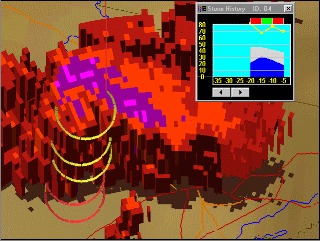Space & Defense
When lives are on the line, Digital Radiance technology helps clearly communicate
the situation, the options, and the best path to success.

Digital Radiance helped Baron Services create VIPIR, the world's first real-time 3-D tornado tracking and forecasting system to integrate data from multiple weather radars. With unprecedented clarity and responsiveness, VIPIR enables meteorologists to quickly pinpoint the earliest stages of tornado formation in the upper atmosphere and communicate it clearly using breakthrough 3-D graphics technology. Meteorologists can literally peel severe weather apart in 3D, looking deep into the most dangerous areas of severe storms and broadcasting it live to the home audience. This real-time view of tornadoes from birth-to-death provides news audiences nationwide with those crucial minutes to get to safety before tornado touchdown.
Long before Google Earth arrived on the scene, Digital Radiance's GeoX technology helped QinetiQ create a real-time 3-D earth visualization system for urban strategic missile defense planning, allowing operators to smoothly and seamlessly zoom from orbit down to highly detailed 3D city streets. Never before had a single tool provided the capability to clearly plan an integrated space-air-ground defense deployment strategy within the context of a realistic downtown environment.
Digital Radiance's GeoX technology was also used on NASA's X-37 automated space plane project. NASA engineers needed a tool that converted their stacks of simulation readouts into an easy-to-understand, real-time 3D presentation tool, and Digital Radiance delivered. By integrating the multiple datasets into a single, unified view that showed exactly how the X-37 performed at every instant in time, everyone on the NASA design team could quickly verify that the vehicle was performing as expected and easily communicate their results throughout the contractor and management chains. Vehicle performance data, such as velocity, attitude, and flight control statistics were displayed as overlays on the vehicle and in the "out-the-window" HUD view.
During the early days of NASA's moon mission redesign program, Schafer Corporation tasked Digital Radiance to develop a narrated animation for a Congressional presentation depicting Schafer's new lunar lander concept. Working closely with Schafer engineers and scientists, Digital Radiance developed the highly regarded animation that has been called "the clearest and most succinct presentation I've ever seen" by high-level NASA and Congressional representatives. The animation depicts the flight concept and multi-level safety features of the vehicle, including the emergency options at every key point in the flight.












